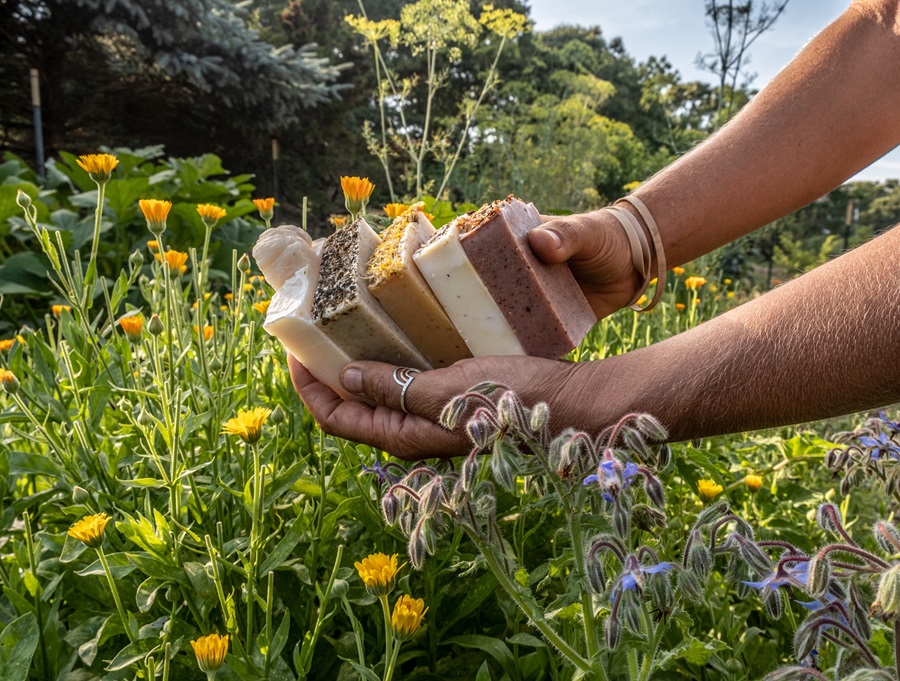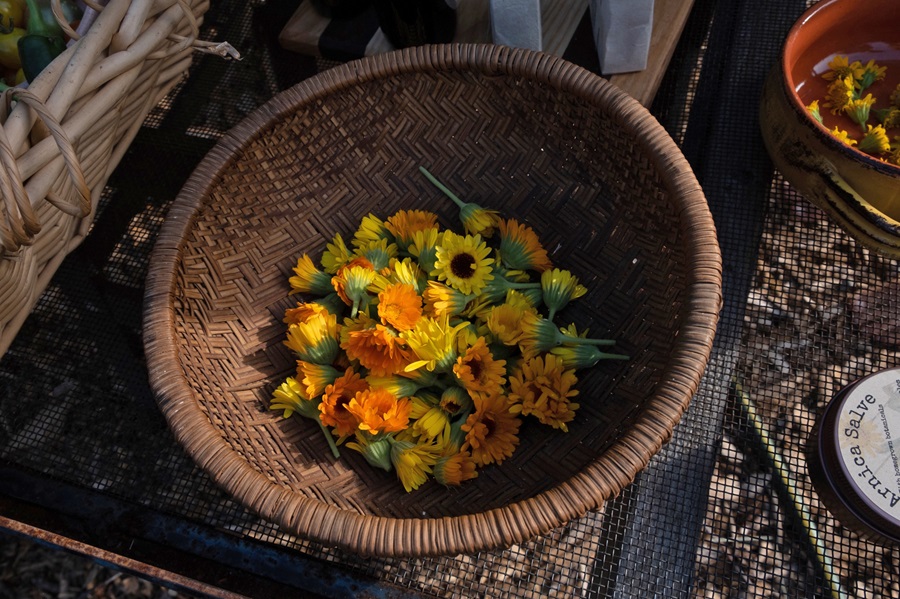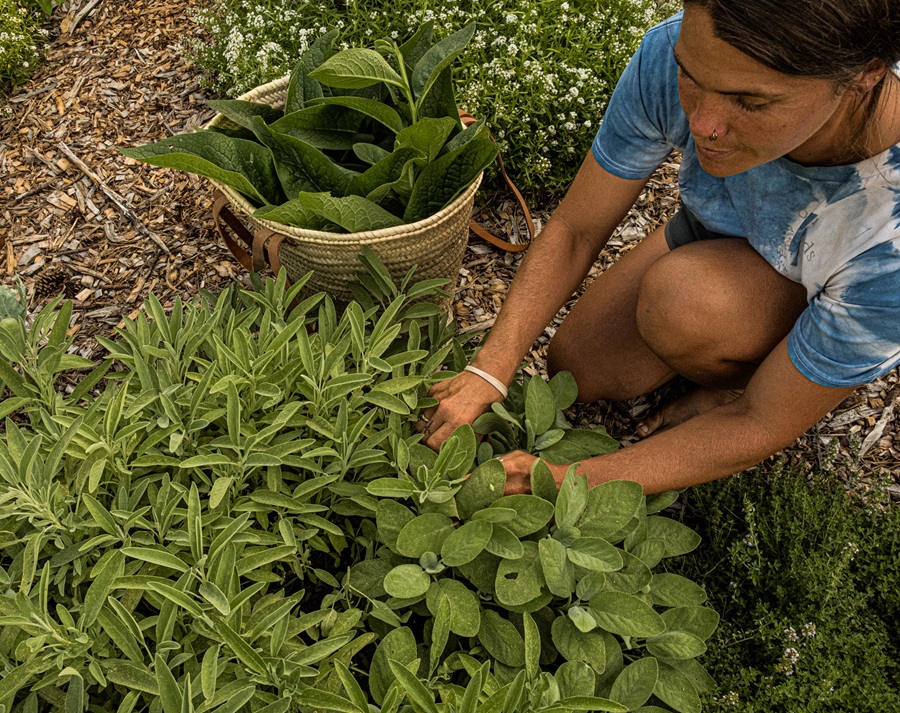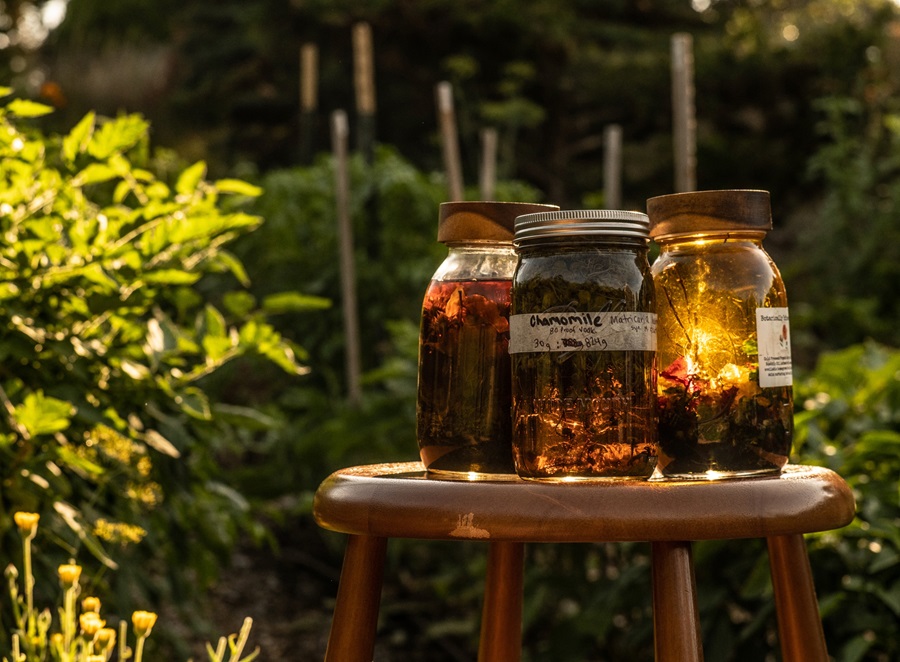Fiona Mulligan is wearing a shirt that she hand-dyed using indigo she grew herself. The color is a dusty purple-blue that stands out against her deeply suntanned skin. Mulligan, who designs edible landscapes for others, tends her own in Eastham. She spends as many hours as she possibly can in her garden. “I’m not always doing work,” says Mulligan. “I like to watch the bugs.”
Hers is a no-spray operation — not even the organic stuff. She trusts that the beneficial insects will devour the harmful ones. On one side of her land, a froth of flowering greenery is crawling with tiny black-and-orange bodies.
“This was a celery plant that went to flower,” says Mulligan. She plunges a hand fearlessly into the mess. “All of these bugs here are called soldier beetles. Their larvae will eat the larva of pests.”

It’s also a no-till operation. Mulligan walks barefoot down her swale walkways, careful not to tread on the dirt beds where her plants grow. “One step can hold a lot of pounds per inch,” she says. To make the beds, Mulligan broadforks them only once. They’re never compacted again. “That way,” says Mulligan, “the plants are able to root very deeply without struggle.” By mid-August, her eggplants and tomatoes have grown tall.
Compacted soil causes all kinds of issues, says Mulligan: erosion, poor water retention, nutrient deficiencies. She’s protective of her painstakingly maintained loose dirt. The idea of people wandering around her garden, reckless and unsupervised, she says, “would be like if someone walked in and just took my boyfriend’s surfboards off the wall and started using them.”
Her plants, which easily reach the deepest dirt, have good immune systems. At the end of the year, she cuts everything flat or pulls it up. In the spring, she adds a layer of compost on top. “That’s it,” she says. “It’s ready for the season.”
Mulligan grows all the vegetables she might need for dinner: carrots and garlic, cucumbers and eggplants, peppers and tomatoes and beans. She also grows the ingredients for her tinctures, soaps, and salves, the things she sells labeled Healing Hands Apothecary.

For her soaps she dries calendula, rose, evergreens, and lavender. In the rental cottage in Eastham she calls her herbal studio, she’ll grind the leaves or flowers into a powder, then pour it into the soap in the making. The result after one to two months of curing: speckled rectangles, colored blush, yellow, gray-green, and white, scented with essential oils, and ready to sell. The top of each soap is decorated with dried flowers, hinting at the scents within.
She makes witch hazel products from her own hamamelis. There’s an arnica salve that incorporates cayenne, comfrey, and ginger for muscle pain. A glass jar, glowing in the late-afternoon light, contains a concoction for the face: cold-pressed apricot kernel oil and rosehip oil, infused for up to six months with other plants Mulligan has grown and dried. The blend, she says, will change based on what’s growing when she’s mixing her products.

Mulligan, is certified in advanced clinical herbalism — a designation she earned through the American Herbalist Guild. But she says she’s grown weary of how trendy herbalism can be.
“A lot of the information out there has been scaring me,” she says. “People think what they’re doing is safe just because they’re using plants.” She doesn’t sell her herbs as medicines, she says. “I don’t want someone taking a willow tincture just because they heard it’s good for something.”
Mulligan grew up in Rutherford, N.J., then farther west, in the town of Harmony. At 18, she moved to England to attend Newcastle-Upon-Tyne University, where she studied nutrition. There she had a realization, she says: “Eating and growing much of your own food and living a life close to the land is one of the most timeless ways to be happy and healthy.” She pursued that idea on stays in India and on travels in Ireland, Peru, Puerto Rico, and Ecuador. In each place she found herself studying village farms and exploring herbalism. In India, she said, “I was tilling fields with horses at one point.”

Back in the U.S. and looking for a place to farm, she followed the advice of a friend who lives in Brewster and moved to the Cape, where she met her boyfriend, Matt Rivers. He hired her to work on the land behind the house where they now live. “He wanted a vegetable garden,” says Mulligan. She decided the garden should be bigger. Now it stretches to something like 100 feet long.
For her birthday last year, Rivers bought her arched trellises, which frame the entrances to the garden. Climbing up one of them is a schisandra vine, a plant native to the forests of northern China, the Russian Far East, and Korea. Also called the five-flavor berry, it’s considered an adaptogen: a plant that helps the body to respond to stress.

Tucked beside the trellis are three varieties — Krishna, Vana, and Kapoor — of tulsi, which is native to tropical and subtropical regions of Australia, Malesia, Asia, and the western Pacific. Mulligan doesn’t include tulsi in the products she sells — the plant is sacred in India, she says, so she doesn’t want to monetize it. “The leaves are fun to crunch and smell,” she says, handing over a sprig. Vana tulsi, especially, is enticingly aromatic; it smells like a blend of clove and cinnamon in a strong, warm tea.
She moved to Eastham for her relationship, she says, but she wouldn’t have ended up on a farm in Maine, like the one some friends of hers just bought. “I need to be close to the ocean,” says Mulligan, even though it means farming only a very small space.

“I always envisioned 50 acres for myself,” says Mulligan. “I’d love to have cows and pigs and chickens.” On the other side of the property, there’s a little orchard — “not ideal,” says Mulligan. “Long story.” The soil is sandy and prone to erosion, she says, since the whole property used to belong to Brewster Sand & Gravel.
But Mulligan grows what she can. “The hazelnuts are actually pretty big and fat right now,” she says.



